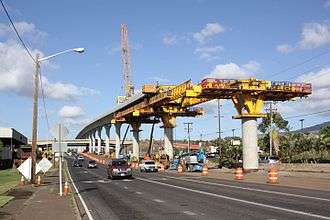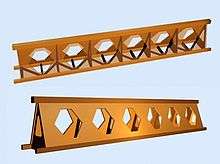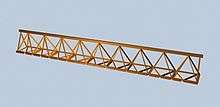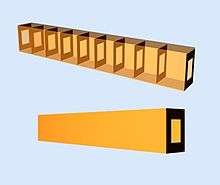Launching gantry
A launching gantry (described also by other terms including beam launcher[1], girder launcher[2], bridge building crane,[3] and bridge-building machine, locally nicknamed the Iron Monster[4]) is a special-purpose mobile gantry crane used in bridge construction. It is used to install precast box girders in highway and high-speed rail bridge construction projects. The SLJ908 is a machine that can carry, lift, and place sections of track, connecting pillars by heavy stone blocks. After pillars are in place and construction has been carried out up to a certain pillar, the machine advances over the gap to the next pillar and drops another block of track into place, spanning the gap. The machine then backs up to collect another block, moves forward, and repeats the process.[4]

An example of a large launching gantry is the SLJ900/32 designed in China by the Shijiazhuang Railway Design Institute and manufactured by the Beijing Wowjoint Machinery Company. This launching gantry is 91 metres long, 7 metres wide, and weighs 580 tonnes.[5] When driving, the machine is supported by 64 wheels, in four sections of 16 wheels each (forming two trucks, one at each end). When launching, the forward end of the machine is supported (on sliding rails) by a strut lowered onto a bridge support column, while the truck for that end hangs off the gantry backbone with no support from beneath. Once the gantry straddles the open span, the work piece is lowered onto the bridge support, and the process reverses to retract the launching gantry. The SJ900 moves at 8 km/h (5 mph) unloaded, and 5 km/h (3 mph) carrying a block of track.[4]
Girder construction
Launching gantries are distinguished by the construction of the main girder of the gantry itself.
Honeycomb girder

The honeycomb girder launching gantry was created in 1999 by ZZHZ, and has proven suitable to a lifting range of 5–300 tonnes.
The main girder of a honeycomb girder is fabricated from welded plates in isosceles triangle section. Regular hexagonal honeycomb holes are cut in the inclined web plate for air currents to pass through. This reduces wind impact.[6] Welded plate by plate, the welding surface will not lose stability easily due to small welding defects.
Truss girder

The main girder of a truss girder is fabricated from welded steel poles. Point-to-point welding (steel poles to pole welding) has a high demand on welding technology. With small self-weight and large deflection, the truss girder launching gantry is suitable for highway bridge construction projects.
Box girder

The main girder of a box girder is fabricated from welded plates. This type of girder is usually used in high-speed railway bridge construction projects.[7]
References
- "Beam Launcher".
- "Segment Assembled Bridge Girder Launcher".
- "Bridge Building Crane for Highway".
- "The mega-machines helping China link the world". BBC News. 22 July 2018. Article with animated diagram of functioning.
- Drummond-Roe, Cecilia (4 December 2017). "Engineering feat of the month: the SLJ900/32 bridge building machine". fircroft.com. Fircroft. Retrieved 8 April 2018.
- http://launchinggantry.com/honeycomb-girder-launching-gantry/
- http://launchinggantry.com/launching-gantry-for-highspeed-railway/